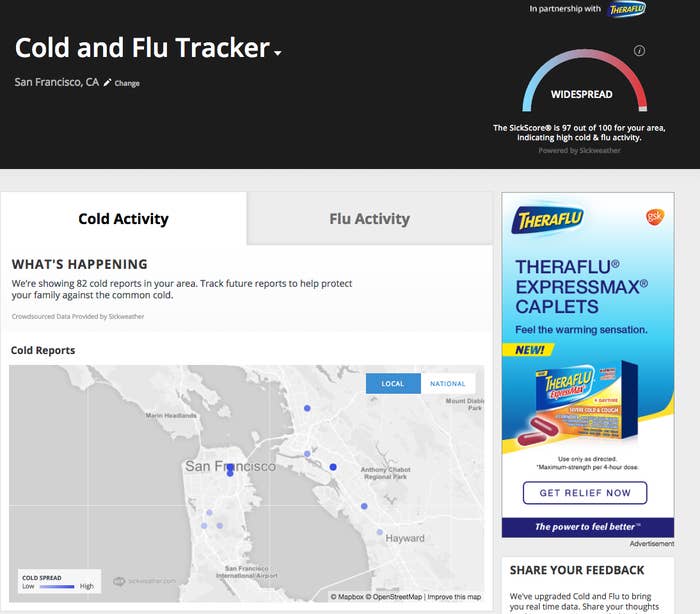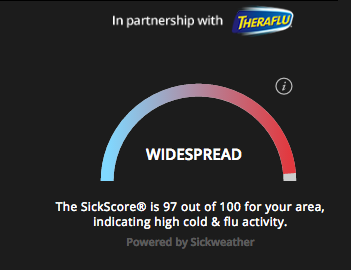
This week the Weather Channel unveiled a “flu tracker” on its website and app. Instead of predicting how rainy or sunny the forecast is, the new map shows the estimated number of cold and flu symptoms in your city based on real-time, crowdsourced social media reports.
Next to the map is an ad for Theraflu, the cold and flu medicine sold by GlaxoSmithKline — the pharmaceutical giant that’s also sponsoring the flu tracker. The ad, which says “get relief now,” leads to a site to buy a box of caplets.
By monitoring up-to-date health risks on the map, people can try to proactively stay disease-free, says the Weather Company, the corporation that provides data to the Weather Channel. In theory, that could include washing your hands more often, or getting vaccinated, or staying home instead of going to work. Or, as GlaxoSmithKline clearly hopes, stocking up on Theraflu.

GlaxoSmithKline doesn’t have any control over the data that goes into the map. But these sorts of flu-tracking maps are notoriously unreliable. Google Flu Trends, for example, shut down last year after a widely publicized Science article challenged its methodology. So some health experts worry that the new one will serve as a promotional vehicle for pharma in the guise of a public service announcement.
“If the information displayed on this platform is not presented in context, I am concerned that this tool could be used to promote their products more than inform the population,” Mauricio Santillana, of the computational health informatics program at Boston Children’s Hospital, told BuzzFeed News.
In an era where the internet allows brands to target customers with ads to an unprecedented degree, a flu-tracking map sponsored by a flu medicine-selling company seems almost inevitable.
The Weather Company already works with Campbell’s, for example, to direct canned soup ads to people when their cities turn unusually cold and windy. The deal with GlaxoSmithKline isn’t fundamentally different, said Jeremy Steinberg, the Weather Company’s head of sales.
“I think what you’ll find across the advertising ethos system is that many companies create content that’s important and relevant to their users,” Steinberg told BuzzFeed News.
And this is just the beginning of GlaxoSmithKline’s partnership with the Weather Company. In the future, the pharma giant says it hopes to target Theraflu ads to people based on hyperlocal social media chatter and weather conditions, and even to use location data from your phone to solicit you when you’re walking by stores stocked with Theraflu. As a GlaxoSmithKline executive said in its press release, the flu-tracker “will not only inform and advise consumers, but it will provide fantastic insights for the marketing team.”

Although paid for by GlaxoSmithKline, the map is populated by Sickweather, a startup that mines public tweets, Facebook posts, and self-submitted user reports for symptoms, such as headaches and chills, that could indicate the spread of cold viruses.
What lives on The Weather Channel’s platforms is a simplified version of the data on Sickweather’s website and app. For each city, the map displays estimated numbers of flu and cold cases — 70 and 84, respectively, in San Francisco on Wednesday, according to a beta version that was live before the official launch — and a “SickScore” scale that sums up the overall “threat level.” For San Francisco, that was 97 out of 100, which the site said indicated high flu and cold activity.
The tool also indicated a high flu threat in Boston, where Santillana works. To the computational epidemiologist, who is not involved with Sickweather but works on flu-mapping tools of his own, the site doesn’t present these numbers in a contextualized or granular enough way to be helpful.
Without information about how outbreaks stack up against historical trends, for instance, “the public does not know whether 84 is good or bad,” Santillana said. The 97 out of 100 score also seems alarmingly high without more information. “If you don’t have a cold, I think that’s very strange, according to that tool,” he said. “If I just saw that without knowing what that means, I would panic immediately.”
Sickweather CEO Graham Dodge told BuzzFeed News that the SickScore reflects the number of symptom reports at the moment divided by population size, and that rates are typically higher in densely populated areas. He added that while the privately held company has not published a paper about the accuracy of its algorithm, he said that, according to internal tests, its predictions have proven 91% accurate up to 15 weeks in advance: This year, Sickweather accurately predicted a flu outbreak two months before it occurred in March.
Dodge also noted that other scientists have seen potential in gleaning public health data from social media. “Generally speaking, I understand the skepticism,” he said, “but numerous researchers have validated the use of social media as a real-time surveillance tool.”
A map sponsored by a pharmaceutical company isn’t inherently misleading — but it shouldn’t serve solely to promote the company’s interests, said Rumi Chunara, an assistant professor of computer science and engineering at New York University. (She runs a flu-tracking study of her own in New York City, which Sickweather will cross-promote soon.)
GlaxoSmithKline, she said, “is funding this now because obviously they have some skin in the game, but there is value to that information.”
